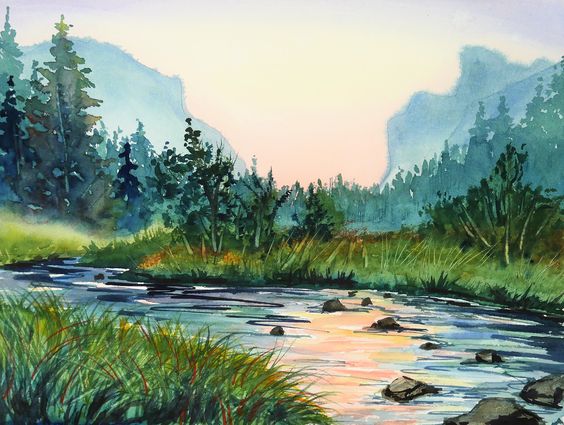
8 Popular Art Styles you can use to paint in
Share
History has seen various different styles of art produced by great masters and local artisans alike. Different styles have been grouped into collective art movements of the time. Here are some popular art styles you can adopt and learn to express yourself in paint.
Impressionism

Impressionism looks to capture fleeting impressions of moments through light effects and weather conditions in everyday life. Impressionists differentiated their art from styles that came before by painting outdoors; before artists painted in studios indoors.
Some Impressionist techniques are:
- Short, quick, thick strokes of paint are applied with the colors side by side with as little mixing as possible.
- Black paint is avoided; complementary colors are used to form grey and dark tones.
- Softer edges are produced since the paint is added on without waiting to dry.
Post-impressionism

Post-impressionism developed as artists’ reaction to the impressionist movement which was popular at the time. Since the impressionists concerned themselves with how light and color are naturally depicted, post-impressionists sought to emphasize abstract or symbolic content in their paintings. They extended the qualities of impressionism while emphasizing geometric, and distorted forms.
Since post-impressionism was a reaction of various artists to impressionism, different artists reacted differently; therefore the post-impressionist movement was a cacophony of different styles such as pointillism. Van Gogh adopted a style that used vibrant and conspicuous brush strokes.
Expressionism

Expressionist ideas seek to present their art from an emotional perspective, conveying moods rather than emotions. Expressionist artists look to defy objective reality for subjective thoughts, opinions, and ideas of the person observing the art.
Some expressionist artists used broad, heavy strokes with thick brushes. Others poured and dipped paint off their brushes while moving around their canvas. Expressionists use distortion, exaggeration, and fantasy through violent and dynamic elements in their content as well as the painting process. Its highly subjective, personal nature, and spontaneous self-expression make expressionism unique.
Cubism

Cubism revolutionized art and sculpture in many ways. It brought about the first inklings of abstract thought in art and presented the painted subjects in a geometrically broken and reassembled light. It represented the subject from different viewpoints instead of one. This view of painting different perspectives of a subject came to be known as multiplicity. Pablo Picasso was the most famous cubist of all. He constructed cubist sculptures from separate elements.
To create cubist paintings,
- Sketch an object from different viewpoints.
- Divide each viewpoint into sections.
- Combine sections from different viewpoints to form an image of an object that you feel represents the real world as it is, three-dimensional and not through a window.
- Combine the negative spaces left behind from each viewpoint and include them appropriately in your cubist artwork.
Abstract Art

In abstract art, subjects aren’t recognizable in person. It uses color, shapes, and lines to deliver a message that is highly subjective and conveys meaning to the viewer. The forms in abstract art exist apart from visuals found in the real world.
Making abstract art can feel like there’s no effort put into it, but it still takes discipline and practice to understand colors, mixing, and composition. Making abstract art often truly explores the joy of painting for the sake of painting.
It is important to provide a unique base foundation for your abstract artwork. It can be a circular design, a grid, a polygonal design, designs based on the shapes of letters, etc. Make sure to add modifications to the shapes to make the structures of your painting have a non-objective feel.
Surrealism

Surrealism was an art movement that looked to capture not aspects of the real world, but as they appear in fantasies, dreams, and the subconscious mind.
The objects in surrealist paintings are usually everyday objects that are juxtaposed in strange, mysterious positions which can make the nature of the objects abnormal. The strange combinations of scenery and objects are to evoke curiosity and provoke a feeling of unease and shock.
Abstract expressionism

Also popularly recognized as modern art (even though modern art encompasses all of the art from the advent of the 20th century), abstract expressionism takes the elements of expressionism such as broad, thick brushstrokes and combined them with abstract concepts to produce paintings that are spontaneous and gestural in nature. It was the first art movement conceived and centered in America, with all preceding art movements having been conceived in Europe.
Abstract expressionist pieces almost always invoke a sense of the movement of the artist’s efforts. Even if there weren’t sweeping gestures involved in the painting process, implied movement can be found in the brushstrokes of the canvas. This is to keep viewers’ eyes moving around the artwork. The artists of this movement touched on abstract ideas such as spirituality, life, death, power, etc.
Minimalism

Minimalism was a direct response to the success of abstract expressionism. Instead of creating movement that leaves the viewer interpreting the painting for hours on end, minimalist art sought to reduce the form and emphasize viewers’ relationships to the art.
The art is mostly based on simple geometric shapes such as the square. It is not a representation of any tangible reality; instead, the art lies in the response and reaction of the viewer to the art. It is also characterized by repetition, monochromaticity, and hard-edged, precise borders between colored areas. Shading and subtle transition are often absent. Minimalism removes all forms of expressionism. It does not look to impress a reality but to evoke emotion.
--
In conclusion, when trying to find an art style that suits us, it’s easier to gravitate towards what style we love and admire. A better way to find our art style would be to try out different styles and decide on the one that invigorates our passion for art and painting. It is important to find value in art that captures us.
The best place to often start painting is to get your first set of paints and brushes. And start painting. Choose a style that you want to portray. If it doesn’t suit your emotion, choose another style. Who knows, you might even come up with your known art style through a stroke of inspiration.
